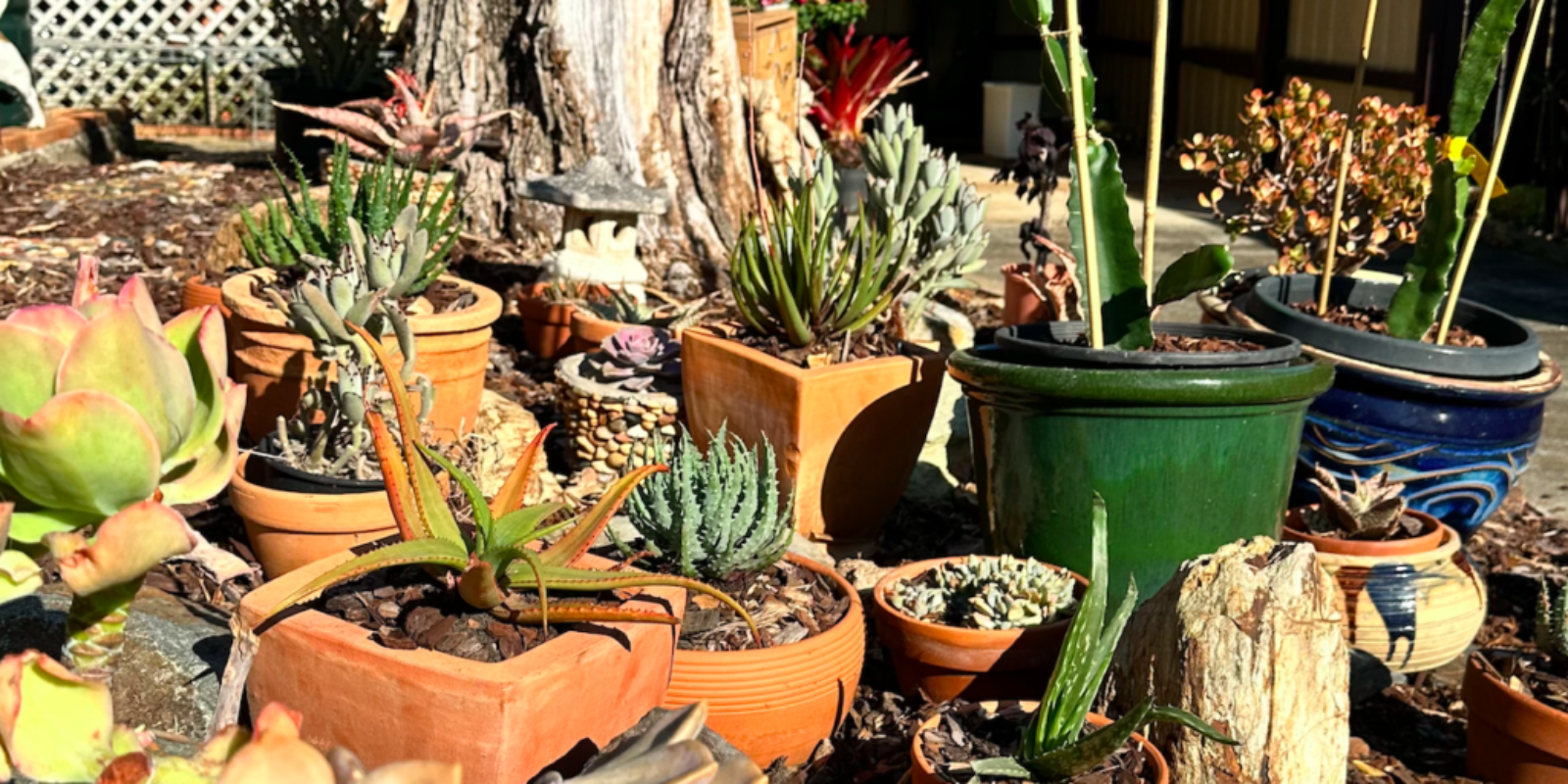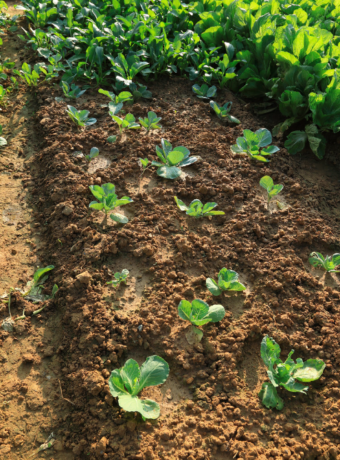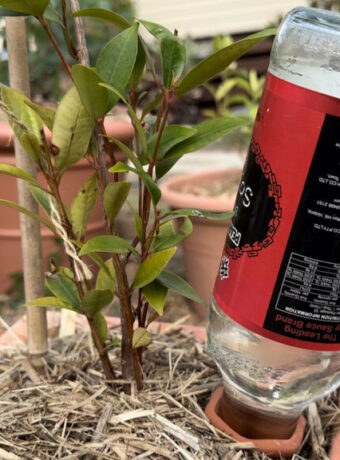There are a number of approaches we can take in permaculture design to build more drought tolerant systems, and in this post I’m focusing on one in particular: replicating desert ecosystems to create a drought-tolerant garden. I recently took a neglected, dry, and sunny garden bed in my front yard that I give virtually no attention to, and started turning it into a low-maintenance garden by replicating many of the characteristics of a desert ecosystem.
There are of course lots of other strategies we can use, like water capture and storage, or irrigation, and these are all valuable. But this post is focusing on selecting plants and structuring our garden in a way that naturally drought-tolerant ecosystems do: deserts.
This is great if maybe you are a renter and you’re not in a position install water tanks or build a swale, maybe you want to care for a garden that you aren’t able to access frequently and you still want the garden to promote biodiversity even if it lacks water, or maybe you have a space that has many of the characteristics of a desert ecosystem, and you want to work in harmony with, rather than against that system.
I want to have a go at replicating a desert ecosystem in this one garden bed. It’s right near my front door, it’s so neglected and I give it virtually no attention. There were some bromeliads that were kept under the stairs, but I had to move them to my shade house where I created a suitable microclimate from broms, because I was simply not willing to water them by hand. This garden is the furthest away from a tap, and I’m not wanting to use water from the tank in this garden so it only gets watered when it rains. Because it’s at the front of my house and people see it all time time, I want to create a low-effort garden that can withstand being in full sun for most of the day, and can rely on the rain.
Characteristics of a Desert
A desert ecosystem is characterised by its harsh environmental conditions, including low precipitation, high temperatures, and often sandy or rocky terrain. Despite these challenges, desert ecosystems are home to a variety of plants, animals, and other organisms that have adapted to thrive in these conditions.

Here are the components of a desert ecosystem:
- Plants: Desert plants have evolved unique adaptations to conserve water and survive in arid environments. They often have reduced leaf sizes, thick waxy coatings to minimise water loss, and deep root systems to access water sources deep within the soil.
- Animals: Desert animals also exhibit various adaptations to cope with the scarcity of water and extreme temperatures. Examples include nocturnal behaviour to avoid heat, specialised water storage abilities, and efficient methods of heat dissipation.
- Soil: Desert soils tend to be well-drained and low in organic matter. They may have high mineral content and be prone to erosion due to infrequent but intense rainfall.
- Climate: Deserts typically have low annual precipitation and can experience extreme temperature fluctuations between day and night. This harsh climate influences the other components of the ecosystem.
- Geological Features: Deserts often feature unique geological formations such as sand dunes, canyons, mesas, and rocky outcrops.
There are Four Main Types of Deserts
- Hot and Dry Deserts: These deserts have high temperatures during the day and relatively cool nights. The Sahara Desert in Africa is a prime example.
- Cold Deserts: Found at higher latitudes or elevations, these deserts experience cold winters and may receive snowfall. The Gobi Desert in Asia is an example. Some cold winter deserts are rain shadow deserts, formed on the leeward side of mountain ranges, these deserts are created by the blocking of moisture-laden air masses by mountains.
- Coastal Deserts: These deserts are influenced by ocean currents and experience relatively mild temperatures due to proximity to water. The Atacama Desert in South America is a coastal desert.
- Polar Deserts: Antarctica and the Arctic are both classified as cold deserts, also known as polar deserts. They are the largest deserts in the world, and they are cold all year round with frigid winters. Instead of sand, the surrounding surface is covered in layers of ice and snow.

Replicating Desert Ecosystems in the Garden
If we want to create a drought-tolerant and resilient garden using principles inspired by desert ecosystems, several aspects can be incorporated:
Plant Selection: Choose native or adapted drought-tolerant plants that have evolved to thrive in arid conditions, or the particular conditions you are designing for:
- Deep Roots: Many desert plants have developed deep root systems that can reach water deep underground. These roots allow them to access water even during prolonged dry periods.
- Succulence: Some desert plants, like cacti and succulents, store water in their tissues. They have modified leaves and stems designed for water storage, allowing them to survive extended periods without rainfall.
- Cyclic Growth: Certain desert plants, such as creosote bushes, exhibit cyclic growth patterns. They grow rapidly when rain is abundant and then go dormant during dry periods, conserving water until conditions improve.
In my garden, I included some edible dragon fruit cacti, a range of succulents and aloes – aloe vera for its medicinal properties, and other flowering aloes that will bloom at different times of the year – and various varieties of desert rose for more colour throughout the year:

Water Conservation: Deserts are characterised by a lack of rain, and they have adaptations that allow them to store water, through underground water reservoirs called aquifers. These are layers of permeable rock or sediment that can store significant amounts of water. Plants and animals in desert regions may tap into these aquifers when surface water is scarce. Using an irrigation technique like ollas could be a way to store water for your plants, and the roots of the plants would ‘tap in’ to that water storage as it’s needed by the plant.

Microclimates: Create microclimates within your garden by using hardscape elements like rocks or walls to provide shade and reduce temperature extremes for plants.
- Windbreaks: Plant windbreaks, such as shrubs or trees, to protect your garden from strong winds that can increase water evaporation and stress on plants.
- Companion Planting: Implement companion planting strategies to encourage beneficial relationships between plants, such as using shade-producing plants to protect more sun-sensitive ones.
Like desert ecosystems, closely observe how your plants respond to changing conditions and adjust your gardening practices accordingly. By incorporating these principles from desert ecosystems, you can create a garden that is not only drought-tolerant and resilient but also ecologically sustainable.



